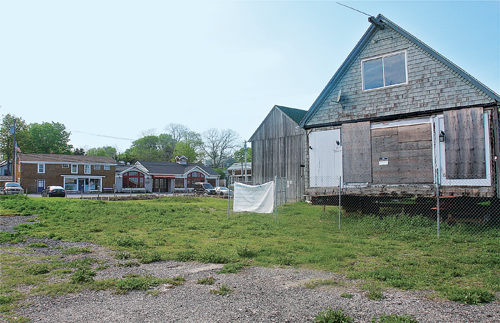Fund leaders hope Galley Ho restrictions will help ease controversy

Faced with concerns from some neighbors — as well as the county health department — members of the New Suffolk Waterfront Fund have amended portions of their proposal to operate a commercial restaurant on a section of the nonprofit’s 2.3-acre First Street property.
A revised site plan still calls for turning the long-vacant Galley Ho building on the property into a 66-seat restaurant, but New Suffolk Waterfront Fund board chairwoman Pat McIntyre hopes several changes will allow the application to move forward without more controversy.
“We wanted to make sure we didn’t impact the community because we all live there too,” she said.
The amended plan was submitted last week to the Southold Town Planning Board, whose members expect to discuss it for the first time in early September.
The tweaks come, in part, as a response to a series of heated debates on the project that occurred at Planning Board hearings and other forums where New Suffolk was described as a “community divided.”
A part of the revised plan includes the waterfront fund board’s newly adopted policy that restricts the number of events held on the property, which has been a major point of contention among residents who fear the neighborhood would become noisy and busy if the application is approved.
Initially, the group hoped to lease the restaurant space to a private vendor and use the rental income to cover the cost of the property’s insurance and maintenance. But now, instead of that hands-off approach, the waterfront fund has adopted a policy limiting any special events to the nonprofit’s signature fundraisers and to restrict the number of outside rentals to no more than three per year, Ms. McIntyre said.
They also adopted policies that restrict parking, hours of operations, amplified music and the number of guests attending special events.
“We understand that this topic is a major concern for our community,” she said. “We didn’t want to have too many rental events because that does have an impact. It means that we will have to go to other sources, like donations from people.”
The revised proposal also calls for a lower profile sanitary system to conform to county Department of Health Services guidelines. The waterfront fund’s original sewer system permit application was rejected by the county in June.
Since the sanitary system would be only about 18 to 24 inches above ground level, rather than 48 to 54 inches above, as originally proposed, it would also intrude less on views of the water and the landscape, Ms. McIntyre said.
However, the existing barn on the property will need to be moved off-site to accommodate the new system, according to the new site plan.
In a letter to residents dated Aug. 15, the nonprofit’s board of directors informed the community of the changes.
“The newly proposed sanitary system covers more land, requiring the barn to be relocated,” the letter reads. “We have opted to find a new home for it rather than move it into the only available location, which would block the water view between the red building and the Galley Ho. Our goal has always been to preserve all the original buildings on the site; unfortunately, this is no longer feasible. Those who love the barn as a visual landmark on the waterfront will be disappointed; relocating it will result in more open space and more open views, both of which were requested by the community.”
The Galley Ho building itself would also be a foot shorter under the new plan.
In a letter to the editor published in this edition of The Suffolk Times, four residents question the waterfront fund’s motivation for the plan changes and question why the health department rejection wasn’t specifically mentioned in the Aug. 15 letter or at any forums.
“The NSWF misrepresents its site plan revisions as reflecting attention to the community’s concerns, never once explaining that the changes were, in fact, mandated by the health department,” reads the letter, signed by Vicky Germaise, Kim and Dan Petrie and Diane and Dennis Harkoff
Meanwhile, another New Suffolk community group has undertaken a survey of hamlet residents to get a better idea of what — if anything — people would rather see built in the area.
The New Suffolk Civic Association mailed out 261 questionnaires last Thursday. The survey asks residents’ opinions on everything from the number of special events they’d like see on the waterfront each year to whether a restaurant should be permitted on the First Street property.
“We decided to find out, once and for all, how many people want what,” said Paul Cacioppo, president of the civic group. “Our goal is to develop a better understanding of where opinions lie, so that we can participate in a more productive – and hopefully less divisive – dialogue with the board of the New Suffolk Waterfront Fund.”
Meanwhile waterfront fund board members said they were taken aback by the survey
“I was surprised to find it in my mailbox Saturday,” Ms. McIntyre said, adding that the survey did not take into account the waterfront fund’s new policy, amended site plan or basic rules under town zoning codes.
Among other things, the survey asks respondents whether a restaurant is an allowable use in that area.
The answer’s simple, said Ms. McIntyre: It is.
“Some of the topics covered on the civic association survey will provide helpful input with our planning and in our round-table discussions, but we would like the community to know that the survey contains several inaccuracies,” she said.
The surveys are due back to the civic association no later than Sept. 6.
The results will be shared with the public during an open meeting at New Suffolk School Saturday, Sept. 13, at 10 a.m.








